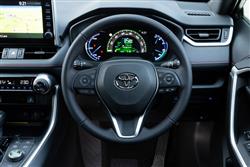Toyota RAV4 Plug-in - ABC Leasing
How will you view?
This is a sample, showing 30 seconds of each section.
HERE PLUGGED(some text hidden)
By Jonathan Crouch
Ten Second Review word count: 86
The first plug-in hybrid version of Toyota's RAV4 draws on more than twenty years of the brand's leadership in hybrid powertrain technology to offer customers a 'D'-segment SUV that promises to be not only more powerful than any other in its class but also more efficient in terms of emissions and fuel consumption. There's quite a price to pay for this technology but the stats look tempting - a total output of 302bhp, an all-electric driving range of 46 miles and a CO2 reading of 22g/km.
Background word count: 204
It's strange that Toyota was one of the last SUV makers to adopt plug-in technology. Primarily because it was the very first brand to introduce plug-in tech of any kind to the market - with the Prius Plug-in of 2012. A second generation of that car was subsequently introduced five years later and we expected to see its technology quickly spread to other Toyota models. This hasn't happened as quickly as expected but at the end of 2019, the brand announced that the fifth generation version of its RAV4, an SUV it originally said needed only self-charging hybrid power, would gain the plug-in variant we're going to look at here. By that time, the mid-sized SUV market was already well populated with PHEV models following a lead set by Mitsubishi's plug-in Outlander. Brands like Peugeot, Citroen, Vauxhall, Ford and SEAT have all piled into this part of the segment, alongside premium makers like BMW, Audi, DS, Mercedes and Volvo. Even though the MK5 model RAV4 initially sold well for Toyota in its self-charging hybrid form, attracting more than 120,000 customer orders in Western Europe in its first year on sale, it was clear that it would also need a plug-in variant to properly compete.
Driving Experience word count: 294
With 302 braked horses-worth of combined system output on tap, this plug-in variant offers quite a big step up in power from the standard self-charging RAV4 Hybrid, which offers 215bhp in front-driven form or 219bhp in four-wheel-drive guise. This PHEV variant only comes in 4x4 form and its power increase comes courtesy of a more powerful electric motor paired to a larger high-capacity underfloor lithium-ion battery, with the powertrain featuring a boost converter on the hybrid's power control unit. The 62mph sprint time from rest is claimed to be just 6.0s and this model can run at speeds of up to 84mph with no intervention from the engine. When the limit of EV driving range is reached, the car will automatically switch to its hybrid vehicle (HV) mode. The choice of driving modes means the driver can use HV mode to start their journey, then switch to EV mode to maximise efficiency, for example when reaching an urban area. In Auto EV/HV mode, the hybrid system will automatically come into play when extra power is needed, for example under sharp, sudden acceleration, then returning to EV mode immediately afterwards. You'll want to know a bit more about the engine. It's the same 2.5-litre Atkinson cycle hybrid petrol unit used in the conventional RAV4. Toyota's electric all-wheel-drive system is also carried over without change, a set-up which sees the combustion engine and a front electric motor powering the front axle and an additional rear-mounted electric motor driving the rear axle. Both motors incorporate regenerative charging to charge the battery, the extent of which can be controlled by the driver via a pair of paddle shifters behind the steering wheel. When fully charged, that battery can take the car to a WLTP-rated 46 mile driving range.
Pictures (High res disabled)

.jpg)
.jpg)
.jpg)
.jpg)
.jpg)
.jpg)
.jpg)
.jpg)

Scoring
Category: Compact Car
| Performance | |
| Handling | |
| Comfort | |
| Space | |
| Styling | |
| Build | |
| Value | |
| Equipment | |
| Economy | 80% |
| Depreciation | 70% |
| Insurance | 60% |
| Total | 62% |